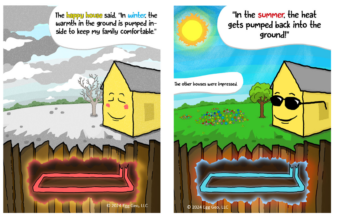By Laura Urbanek
The Department of Energy is continuing its assault on the appliance energy efficiency standards program, with a proposed interpretive rule out this week that could freeze in place the standards for residential furnaces and commercial water heaters that use natural gas or propane. This shortsighted proposal could waste substantial amounts of fossil fuels and cost consumers billions in wasted energy costs. It’s a massive shift by DOE, which had already addressed this issue multiple times, as recently as 2016.
Fossil (aka “natural”) gas and propane are popular fuel sources for space heating and water heating in the United States, but when burned inside homes and businesses they emit climate-altering pollution and can impact indoor air quality. About half of homes are heated with fossil gas, and most of those homes used a gas furnace. Space heating represents the largest energy expense for the average U.S. household, accounting for about 45% of energy bills.
Standards for residential natural gas furnaces were last meaningfully updated in 1992, which means that many homeowners are already wasting climate-harming fossil fuels when they heat their homes. More efficient standards for furnaces, alone, could cumulatively save consumers $24 billion on their utility bills by 2050, while reducing harmful carbon pollution by nearly 85 million metric tons (equivalent to the annual emissions from 22 coal-fired power plants). But with this proposal, these savings are all but guaranteed to be lost, as DOE yet again prioritizes industry interests over the health and well-being of consumers and the planet.
Last fall, groups representing the gas industry—American Public Gas Association (APGA), Spire, Inc., the Natural Gas Supply Association (NGSA), the American Gas Association (AGA), and the National Propane Gas Association (NPGA)—petitioned DOE to change how it interprets the definition of “performance characteristics” as it relates to gas furnaces and commercial water heaters. While this gets wonky pretty quickly, the issue boils down to the use of condensing or non-condensing technology.
Condensing vs. Non-Condensing
Furnaces or water heaters using condensing technology capture additional heat from the flue gases that would otherwise be lost up the chimney, and return usable heat. This results in a more efficient furnace or water heater with significant energy savings for consumers. In fact, without the use of condensing technology, there is little room for energy efficiency improvements over existing models of gas equipment.
The energy-saving benefits of condensing technology are immense. A recent report from the Appliance Standards Awareness Project found that condensing technology can reduce residential gas water heater energy consumption by about 25 percent. DOE estimated in a September 2016 furnace supplemental proposed rule that consumers would save about $700 on average by purchasing a furnace that complies with the proposed standard, after accounting for all costs (including any relevant venting and plumbing costs related to installation).
DOE Changes its Tune
Condensing equipment requires different venting compared to non-condensing equipment, and also requires a plumbing connection to dispose of the condensate produced. The gas industry groups argued that the presence of this different venting and a plumbing connection are “features” or “performance characteristics” that require these products to be put in a separate product class, with separate standards for condensing and non-condensing products. That’s a problem, because it means that inefficient furnaces and water heaters that waste energy by not utilizing up-to-date technology will still be available on the market—which defeats the purpose of a higher energy-saving standard that benefits all consumers.
We do not agree with the gas industry groups’ interpretation of what constitutes a “performance characteristic,” as we laid out in comments submitted to DOE on the petition back in March, In fact, we find what the gas industry groups requested to be contrary to the law.
What’s more: DOE itself previously disagreed with this interpretation! The gas industry groups have been looking for a way out of updating the standard for years, and each time, DOE has given a consistent, rational explanation for its decision to not treat condensing products as a unique product feature. Most recently, DOE cautioned in the March 2015 residential furnace notice of proposed rulemaking (NOPR), and reconfirmed in its September 2016 supplemental NOPR, “Tying the concept of ’feature‘ to a specific technology would effectively lock-in the current existing technology as the ceiling for product efficiency and eliminate DOE’s ability to address technological advances that could yield significant consumer benefits in the form of lower energy costs while providing the same functionality for the consumer.” Yet this is exactly what the gas industry groups asked DOE to do in the petition at hand, without providing a compelling reason for why DOE should reverse its long-held, consistent determination of product classes.
Unfortunately, DOE has done a 180-degree turn to change its position, now agreeing with the gas industries—to the detriment of consumer energy savings. DOE claims that they’re looking out for the consumer, citing concerns about how exterior venting could impact the aesthetics of a home, and that requiring better technology would result in financial hardship to low-income consumers. Yet, groups like the National Consumer Law Center and the Consumer Federation of America—whose job day in and day out is to represent interests of low-income consumers—are strongly opposed to DOE’s approach. They note that consumers—especially low-income consumers—will suffer “substantial financial harm,” losing out on billions of dollars in energy savings under the proposal at hand.
There are more steps DOE needs to take before this is a done deal, and we’ll be fighting at every step of the way. Changing the rules to stymie progress is not in the best interest of consumers, especially low-income consumers who spend a disproportionate amount of their income on energy bills. This proposal rests on shaky legal ground, and even worse, it wastes fossil fuels. And when fossil fuels are responsible for so much of the climate crisis, a proposal to increase waste is simply unconscionable.
 Laura Urbanek is Senior Energy Policy Advocate, Climate & Clean Energy Program, NRDC.
Laura Urbanek is Senior Energy Policy Advocate, Climate & Clean Energy Program, NRDC.



